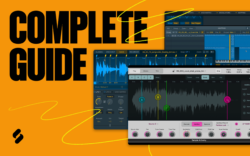The Torso S-4 is a one-of-a-kind sculpting sampler with some of the quickest and most intuitive workflows across any hardware device.
With its OS 2.0 update, the Torso S-4 unlocks a powerful set of new tools including macro controls, scene snapshots, varispeed recording, dynamic modulation, and more. In the in-depth guide above, we walk through everything you need to know to get started with the sampler—watch along to hear it in action, and read highlights below.
How to create a new project with the Torso S-4
First things first, to create a new project with the Torso S-4, simply hit the “project” button located on the top left of the device, and then hit “CREATE NEW PROJECT” on the screen.
You have four buttons underneath the screen that you can use to select on-screen menu options. The eight encoders on the top right of the device are also dynamically linked.
The 5 main modules of the Torso S-4
The Torso S4 allows for four tracks, and on the screen, you can review the default flow of the five modules for each track: (1) the Material device goes into (2) the Granular engine, which goes into (3) the Filter module, which goes into (4) the Color module, which lastly goes into (5) the Space module.
Let’s dive into each of these modules in more detail below, starting with the Material device.
1. The Material device
The Material device is the Torso S-4’s sound engine that allows you to load samples as tracks. The options you can choose from include DISC, TAPE, POLY, and BYPASS. The default is DISC, which streams directly off of memory, whereas TAPE loads up to a buffer and features some unique parameters. Meanwhile, POLY is great for plugging in a MIDI keyboard via USB or MIDI In.
At 1:39 in the tutorial above, we showcase how you can load and manipulate samples from Splice using the DISC mode.
2. The Granular engine
The Torso S-4 also supports granular synthesis via its Granular engine, which is a technique that allows you to adjust and reorder small segments (“grains”) of a longer sample to produce a unique output.
With the S-4, you can control various parameters including the pitch, rate, size, contour, warp, spray, and pattern of your grains—hear this in action at 4:50 in the tutorial.
3. The Filter module
The Filter module offers filters with manipulatable cutoffs and slopes, allowing you to easily set up common filter types like band-pass, high-pass, low-pass, etc.
What makes the S-4 unique from other samplers is its musical-sounding resonant peaks, which can be achieved in conjunction with the scale and decay parameters—at 6:40 in the tutorial, we demonstrate how you can get some really unique timbres from something as simple as a minor scale.
4. The Color module
The Color module provides compression and distortion capabilities to help you add some glue, warmth, and grit to your sounds. Paired with a visually-engaging workflow, the module supports bitcrushing, sample reduction, different noise types, and more.
5. The Space module
Last but not least, the Space module offers multiple lush reverb and delay options that can give your sounds a real sense of room and depth.
Access the world’s best sample library and connected creator tools.
Additional key features: Modulation and macros
Separate from the S-4’s main modules are an array of other features for sculpting your sounds, including key functionalities like modulation and macros.
1. The modulators
There are four modulators available, which you can view by pressing the “mod” button on the bottom left of the device.
The different modulation sources you can choose from include:
- WAVE: Simple waveforms that can be shaped and skewed.
- RANDOM: Randomly generated shapes that allow for unique sound design.
- FOLLOW: A feature that follows the established envelope.
- ADSR: A standard ADSR (attack, decay, sustain, and release) envelope builder.
To assign modulation, simply go to a desired parameter and hold the “mod” button—we demonstrate this process at 3:35 in the tutorial.
2. The macro system
The macro system, which can be accessed via the “perform” knob, is highly useful for mapping multiple parameters for on-the-fly editing and live performance applications.
The “temp” button can be particularly powerful when used in combination with the macros—you can hold it to temporarily change multiple parameters, which will revert to their original positions on release.
The Torso S-4 sculpting sampler: Conclusion
And there you have it—while there’s plenty more to explore, you should now be ready to hit the ground running with the Torso S-4. Be sure to also check out the rest of the tutorial video, where we dive into a few more advanced applications and examples.
Do you already use the Torso S-4 in your own workflow? What other tools would you like to see us overview next? Let us know in the comments section of the video, and subscribe to the Splice YouTube channel for more tips, tutorials, and insights.
Explore royalty-free sounds from leading artists, producers, and sound designers:
July 21, 2025

.svg)
.svg)



